SAO 145171 HD 201567 mag, 6.27 KIII 6.27 346ly
Flo 0.048 au = 4,500,000 miles 4.4 when closest
http://www.mantrapskies.com/image-archive/OTHER/FLORENCE/florence.html
Discovery date : 1981 03 02
Discovery site : Siding Spring
Discoverer(s) : Bus, S. J. Schelte "Bobby" Bus at Siding Spring Observatory in Australia
Asteroid (3122) Florence came closer to the earth on September 1, 2017 than any asteroid its size or larger has since we've been keeping records of such things. It is an Amor class asteroid. That's one with an orbit that is always outside that of the earth with its closest approach to the sun being less than 1.3 AU but not less than 1 or 1.017 AU. Some disagreement about 1 or 1.017. Its perihelion distance is 1.02 AU so can't quite hit us. But since it goes out in the area of Jupiter that could change in the distant future if Jupiter's gravity changes the orbit just the right (or is it wrong?) way.
It was discovered by Shelte (Bobby) Bus at Siding Spring Observatory (Australia) on March 2, 1981. It was named for Florence Nightingale. While its closest passage was August 1 (early morning US time) I made this a day earlier. The difference is small as it was only 2% further away and moving about 4% slower. Moon was closer to it and my skies hit by heavy smoke from British Columbia fires when closest. I'd planned to take it over several nights hoping the weather would be good for one. Seeing was awful when I took it a day before closest approach with it rather low in my skies where I need great seeing. Also, it was quite windy with winds of over 30 mph. Often I can survive such wind but not this night. The one two punch of wind and poor seeing had an odd effect on the star trails. Both moved them around over the one minute of each exposure. The result is that in the time lapse the star trails wave about like crazy. Wish I could try again but that wasn't impossible. It is getting higher each night but the moon is getting closer and brighter. Last two nights have been foggy and rainy respectively. A nearly full moon lit up the sky greatly. This will have to do for now. It will still be around when the moon gets far enough away and ebbs some so I may try again though it will be moving slower.
The bright star it passes by is HD 201567 a magnitude 6.3 KIII star. The asteroid is about magnitude 8.7 in my animation. Comparison to trailing stars makes an accurate measurement difficult. I was getting 8.5 when compared to moving stars. This would be too bright. My crude compensation says 8.7 which agrees well with other estimates. Each frame is a 1 minute exposure tracking the asteroid. Due to bad seeing and wind, it is bloated but the bloat was rather consistent on each frame. There are thirty frames, one minute frames. Due to the time needed to download each frame (about 4 seconds) the animation covers about 32 minutes of time. The frames were taken at 1.5" per pixel but reduced from that a bit for the animation. No alignment was used. The mount held dead on the asteroid the entire time. But it does quiver a bit, same as the stars due to seeing.
Radar observations of it, resolved two moons according to this Sky and Telescope Magazine link http://www.skyandtelescope.com/astronomy-news/asteroid-florence-has-two-moons/. Both appear too faint and small to see visually.
I had some email from the fringe predicting all sorts of disaster to earth. Some telling me to repent before it is too late. One has written me several times about other "end of the earth" passages by comets or asteroids. This time he was sure he was right. I'm sure I'll hear from him again in October when one, smaller but still very dangerous if it hit, passes by much closer than Florence did. I expect he will be sure to be right yet again. A 100% failure rate doesn't discourage these folk.
I was in a quandary how to present this animation. An animated GIF was over 2 meg in size so too big. I've been told some browsers can't easily view the WMV file I've used in the past. When I converted it to an MP4 file I couldn't make it repeat. Club member Mark Dahmke to the rescue. He found a way to turn it into a web page that did repeat. Rather simple but beyond my limited abilities. I believe any modern browser that supports HTML5 (now used by YouTube and others) can handle this. Let me know if you have problems.
14" LX200R @ f/10, L=30x1'x3x3, STL-11000XM, Paramount ME Related Designations for FLORENCEFLORENCE, | Video: https://images.mantrapskies.com//catalog/OTHER/FLORENCE/FLORENCE.WMV Video: https://images.mantrapskies.com//catalog/OTHER/FLORENCE/FLORENCE.mp4 Video: https://images.mantrapskies.com//catalog/OTHER/FLORENCE/FLORENCE1.wmv 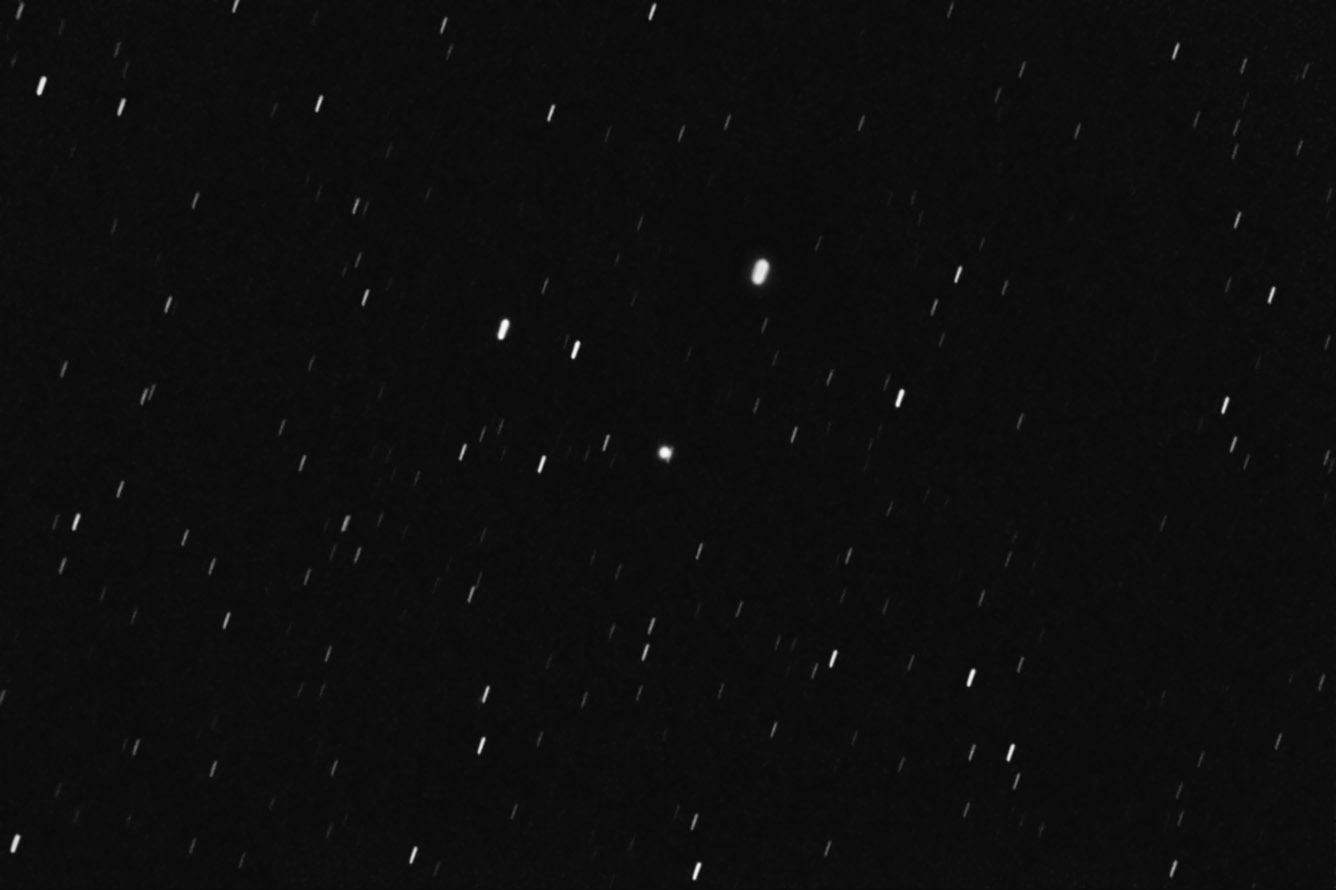
FLORENCE14.JPG
Video: https://images.mantrapskies.com//catalog/OTHER/FLORENCE/FLORENCE7.mp4 | LBN 902 and GAL 201.6+01.6 swimming in the dark nebula LDN 1608. These are located northwest of the Fox Fur Nebula, NGC 2264 in the constellation of Monoceros. The entire area is full of HII, reflection and dark nebula. I find no distance estimate for it and the estimates of the many nebulae in the area vary from 1000 to 8000 light-years so that is of no help. It appears to be a combination reflection (blue part) and emission (red) nebula somewhat separated from the general HII emission of the area by the dark nebula LDN 1608. I suspect it more likely related to the dark nebula than the general emission nebula of the area and thus likely in front of the emission nebula.
I have no idea why I imaged this one. I left no notes and find nothing much on it in the literature. There are many far better nebulae in the area. I must have had a reason. I just don't know what it was!
14" LX200R @ f/10, L=4x10' RGB=2x10', STL-11000XM, Paramount ME | 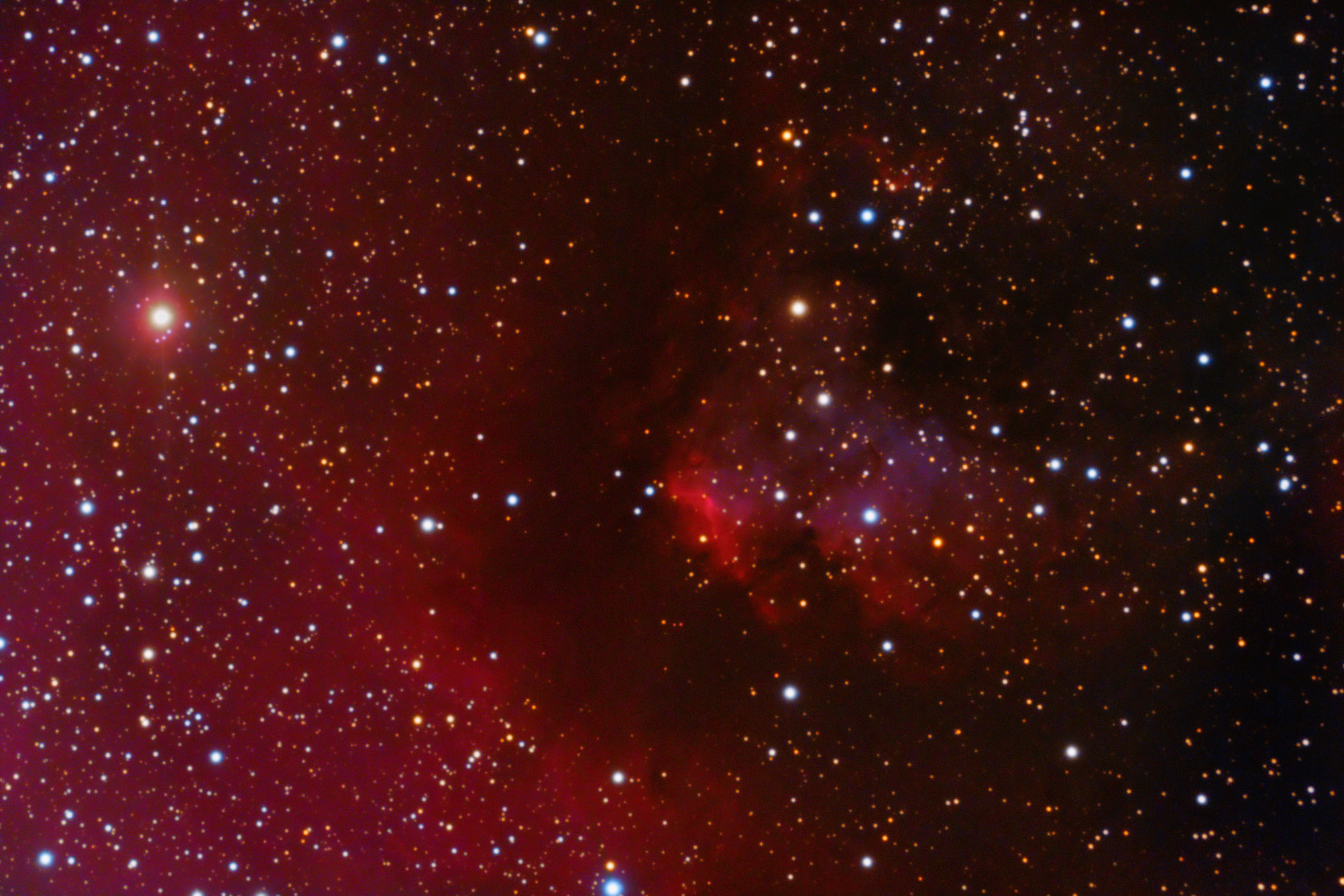
GAL20136.6+01.6L4X10RGB2X10R1.JPG
| GK Persei is also known as Nova Persei 1901. While supernova can create remnants so can nova. This nova remnant is located only 470 parsecs away from us (1500 light-years). The remnant is large enough to be easily seen though very faint. Changes are evident in it due to its expansion in only a few years. I hope to revisit this one in a few years to see if I can resolve the expansion. As usual, for most of the last year and now into 2013, the transparency has been awful. I didn't get as much of it as I'd hoped. To do it justice I need an OIII filter as well as H-alpha but as yet that is still on my wish list. The star is still unstable erupting every three years since about 1980 as a dwarf nova. Very deep images show a jet coming out to the northeast. It takes much more exposure time to pick it up than I gave it. I was surprised I picked up quite a bit of IFN in the area. Since most images of it are narrow band they miss this structure. It came as a surprise to me as I was processing the image. It is seen in very deep images that show the jet, I'd just not noticed it for some reason. Due to all the colors seen in the remnant and the way it radiates out from the center it is sometimes known as the Fireworks nebula for its resemblance to a starburst fireworks shell -- a really powerful one!
There wasn't enough in the image to prepare an annotated image. No galaxy with a known redshift was listed in NED. The lone bright galaxy in the image is 2MFGC 02926 to the lower left. The only magnitude NED has for it is 13.6 and that is in the Infrared K band.
14" LX200R @ f/10, Ha=4x30', L=4x10' RGB=4, STL-11000XM, Paramount ME | 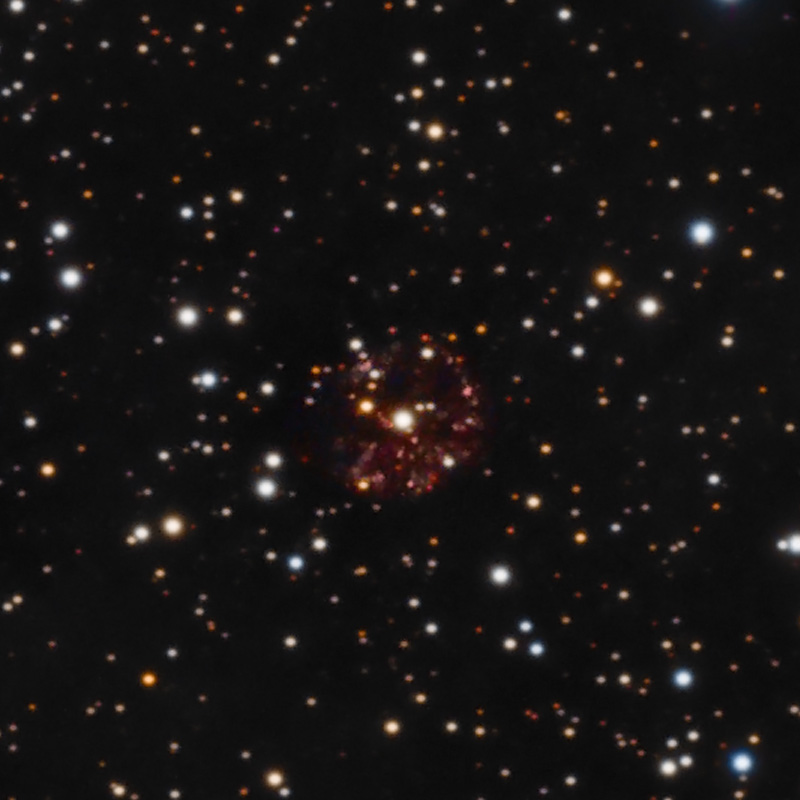
GK_PERSEI_Ha4x30L4X10RGB2X10CROP150.JPG
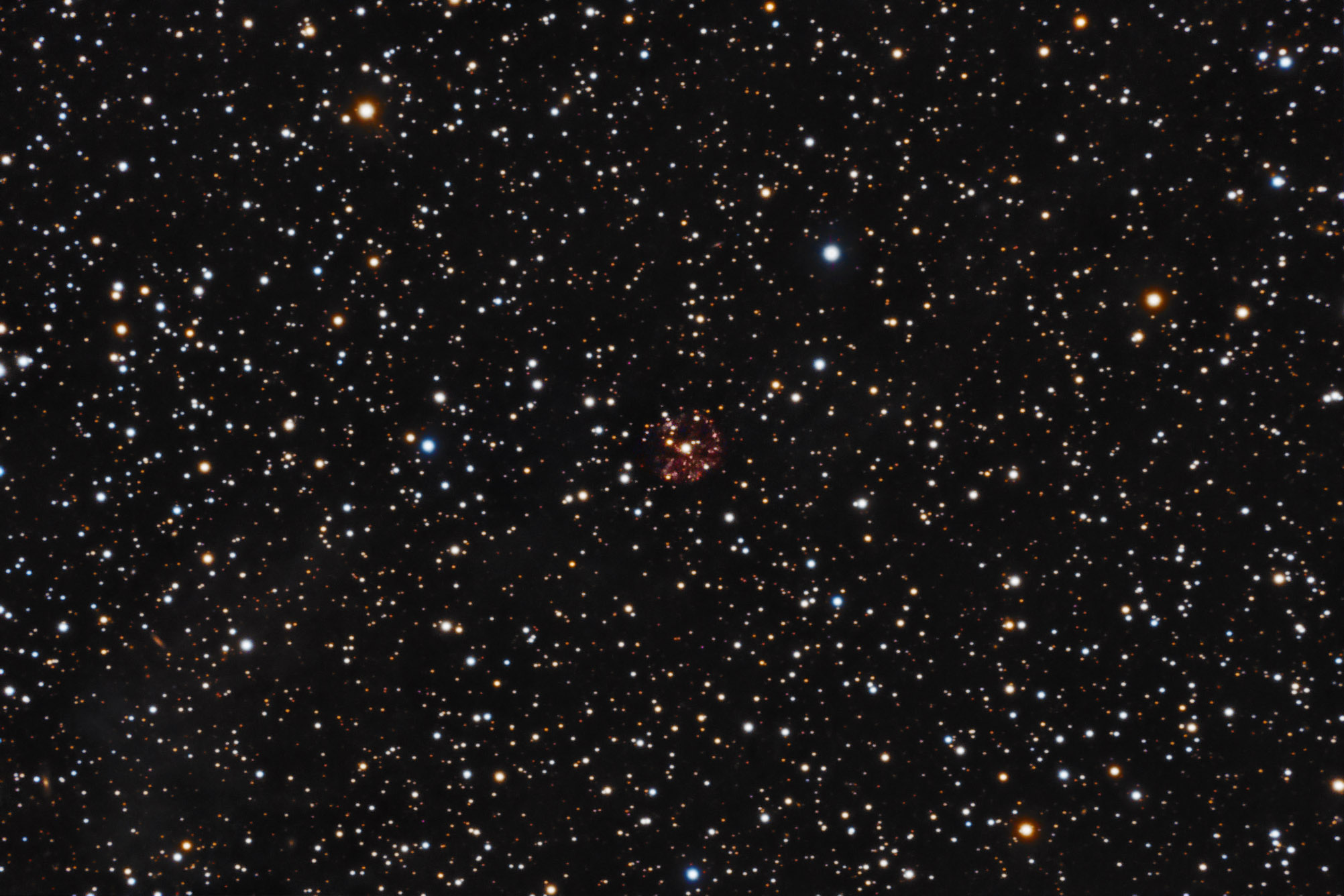
GK_PERSEI_Ha4x30L4X10RGB2X10R.JPG
| Magakian 104/GN 05.28.8 is a beautiful blue reflection nebula in the larger nebula of Ced 51 that gets nowhere near the respect it deserves. It is in the head of Orion. Apparently, it is lost due to the other showpieces in that constellation. I can't find much on it at all.
My image was hurt by a haze that varied from thin to rather thick robbing me of lots of photons and creating large halos around stars as well as fuzzing detail. Blue was especially hard hit with large halos around even red stars. Removing them was nearly impossible and took far more time than the image is worth. But with my horrid 2012 conditions that is the norm it seems. I'm getting to be a broken record on the subject. It's frustrating spending several hours more to process an image simply because of what the weather did to my data.
The small dark nebula in the red emission nebula at the top of the image is LDN 1584. Out of the frame at the top is the much larger and darker Barnard 32. The entire field including Barnard 32 can be seen at http://www.astrobin.com/30585/B/ . The image is mirror flipped with east on the right instead of the left. I hope that doesn't bother you as much as it does me. It was taken under far better Arizona skies.
If you have very good eyesight you might see the asteroid (232412) 2003 EL3 near the top right of the image. It isn't very bright at Magnitude 19.4. Even fainter and harder to find is (207288) 2005 GJ14 near the top left of center at magnitude 20.5. Quite a few galaxies are in the image but not a single one is listed by either NED or SIMBAD. So I never made an annotated image.
14" LX200R@ f/10, L=4x10' RGB=2x10' through varying haze and lots of green/brown airglow, STL-11000XM, Paramount ME | 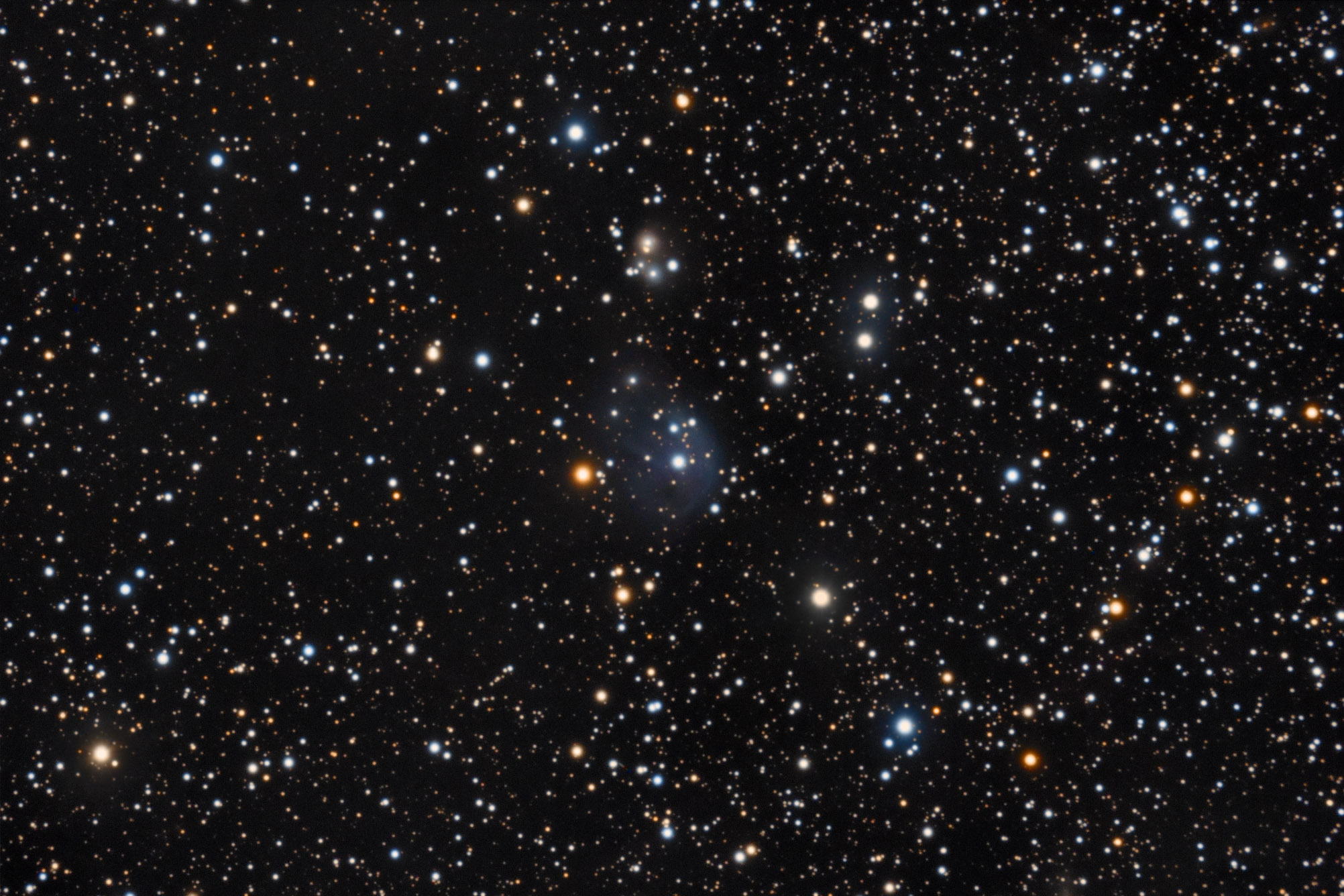
GN05-26-7L4X10RGB2X10X3r.JPG
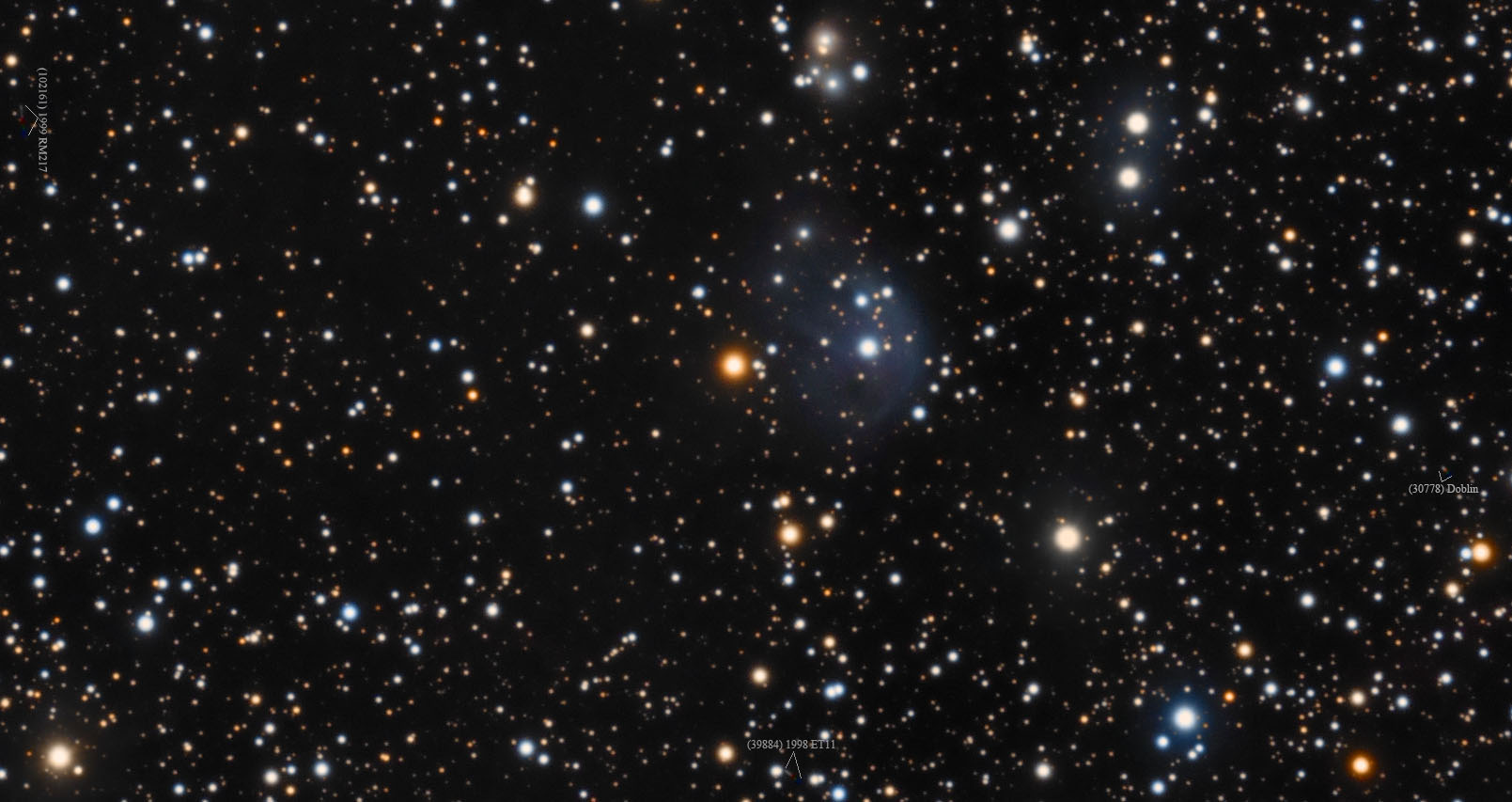
GN05-26-7L4X10RGB2X10X3r1-ID.JPG
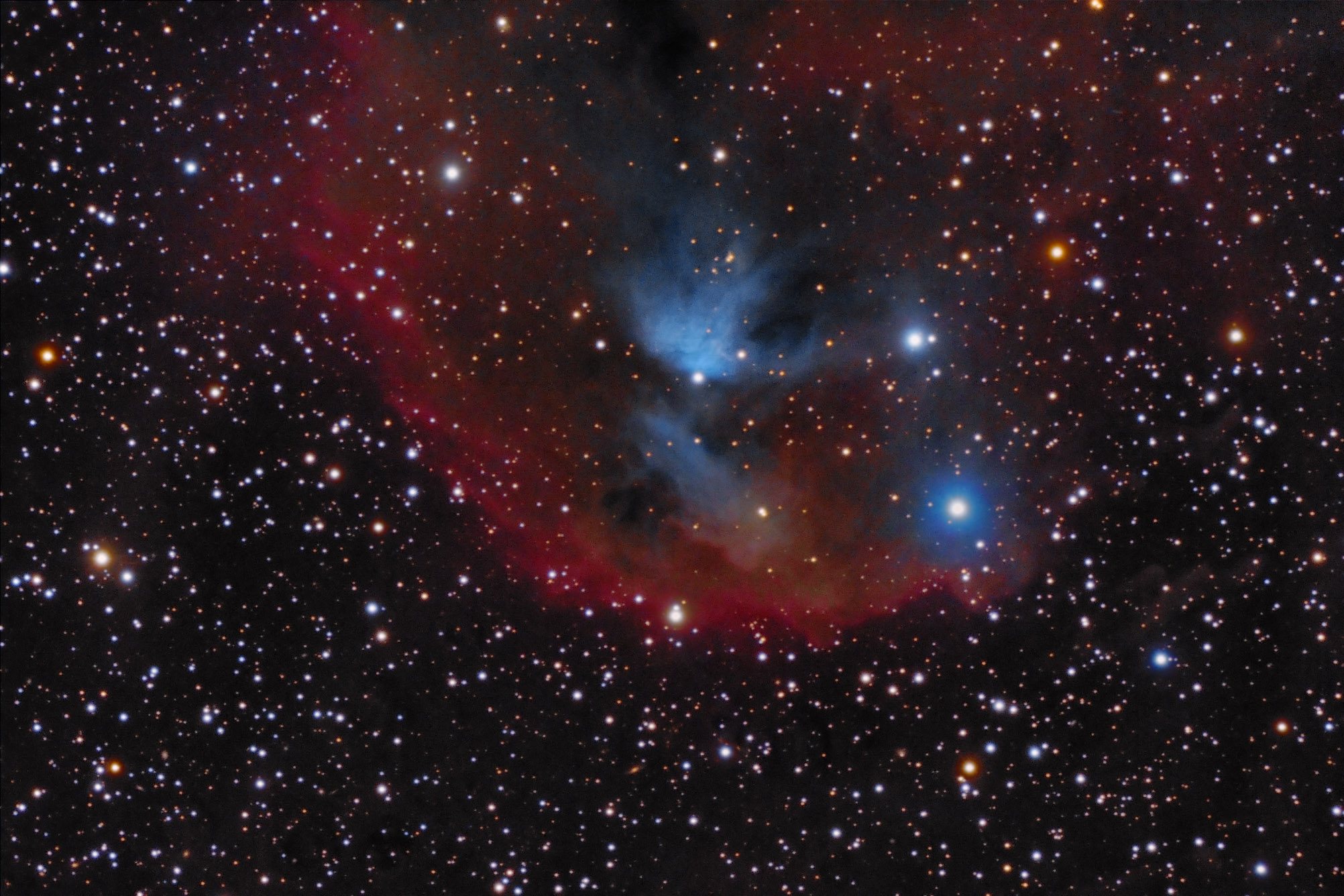
GN05-28-8L4X10RGB2X10R.JPG
| GN 20.16.3.02 is a small reflection nebula surrounded by the much larger DB 82/IC1318A. The field is located in Cygnus about 1.8 degrees northeast of Sadr I couldn't find anything on the reflection nebula, not even a distance estimate. Most put the nebula associated with Sadr at 2000 to 5000 light-years. But how the reflection nebula relates to the HII region isn't mentioned. I suspect the reflection nebula is due to a bright star embedded within the HII region.
There is a dark nebula or patch southwest of the reflection nebula. I wasn't able to find it in any catalog though it is quite obvious. Less obvious is the much larger dark area to the NE of the reflection nebula just beyond the edge of the brighter red nebulosity. It is rather round with a bright blue star seen against it. It is DOBASHI 2453. Just above it is a larger dark region which is DOBASHI 2465. On my right edge is a line of 4 bright stars with a scattering of fainter ones behind the group. This is the open star cluster [FSR2007] 0226.
My limited field doesn't begin to see all of IC 1318A. For that see Jim Thommes excellent wide-field view of the nebula at http://jthommes.com/Astro/IC1318NW.htm . His image uses a lot of HII data which I didn't take. His annotated image shows a lot of the identifications of the bright nebula within IC 1318A.
This is yet another severely smoke damaged images. I took the green data when a denser cloud went over so it was very weak. I was able to use only one of the green frames and it was much weaker than the blue filter. Blue was hit too hard for eXcalibrator to salvage so I had to sort of fake the blue then use it to help the green. That means my color is very highly suspect but at least it looks fairly good. Also, the smoke caused some severe halos around all but the redder stars. I spent most of a day dealing with the halos. Oddly they weren't seen in the RGB frames but were in all luminance frames. After taking the luminance I had to stop as the smoke was too thick for even the red filter. After an hour it cleared enough to take the color frames but hit again when taking the green data. By then I was in bed and didn't know it was clobbered. This one may be worth revisiting once the clouds and smoke go away. New fire in California is sending more smoke my way. Last I heard it had zero containment. It started well after this object was taken but means once the clouds clear I'm still likely seeing smoke.
14" LX200R @ f/10, L=4x10', RB=2x10', G=1x10' (weak), STL-11000XM, Paramount ME
Rick
| 
GN20.16.3.02RB2X10G1X10R-67.JPG

GN20.16.3.02RB2X10G1X10R.JPG

GN20.16.3.02RB2X10G1X10RCROP-67.JPG
| This field is located less than a degree north-northeast of Sh2-120 and Sh2-121. The night allowed me to pick up the general H alpha glow of this part of Cygnus north of the North American Nebula. The field is a nice mix of light and dark nebulae and is an area of newly forming stars judging by all the Y*Os in the field (Young Stellar Objects -- that is, stars still coming out of their dust cocoons and moving onto the main sequence where they will spend most of their lives as ordinary stars).
While I've identified some of the Y*Os in the image it is only a few of them. Labels on top of labels would have been the result in some areas had I tried to cover them all. I gave a taste of how many could crowd in an area around LBN 408 near the top of the image.
There's an object down toward the bottom right of the image that makes a sort of squashed ring. I was unable to identify it. A piece around a red star was GN 21.00.7. A condensation to the west of this is MHO 958 an emission object. A very faint, difficult to see speck to the left of GN 21.00.7 is HH 1051. There are a dozen more HH (Harbig Haro objects) in the image, all such faint specks I didn't bother to point them out, many more were below my exposure time to even detect. But what that ring itself is I couldn't find out. Others have identified it as GN 21.00.7 but that just doesn't fit unless the GN designation is for the "illuminating star" and it is a reflection nebula. That doesn't seem to fit other GN objects however unless they are vdB objects which this is not. I'm not well versed in identifying these objects so if someone has the answer please let me know.
There's an interesting HH object (HH 389) just to the northwest of this field that I took in November. It was taken on a better night so goes a bit deeper. I considered mosaicing all three (including Sh2-120-1) but the nights were so different as to transparency it would be very difficult to get it to work so I gave up that idea. Turns out there's a lot of interesting stuff for a high resolution system in this part of the sky normally imaged with wide angle systems. Those wide field images make a nice set of "survey plates" for me to find these small objects.
14" LX200R @ f/10, L=4x10' RGB=2x10', STL-11000XM, Paramount ME | 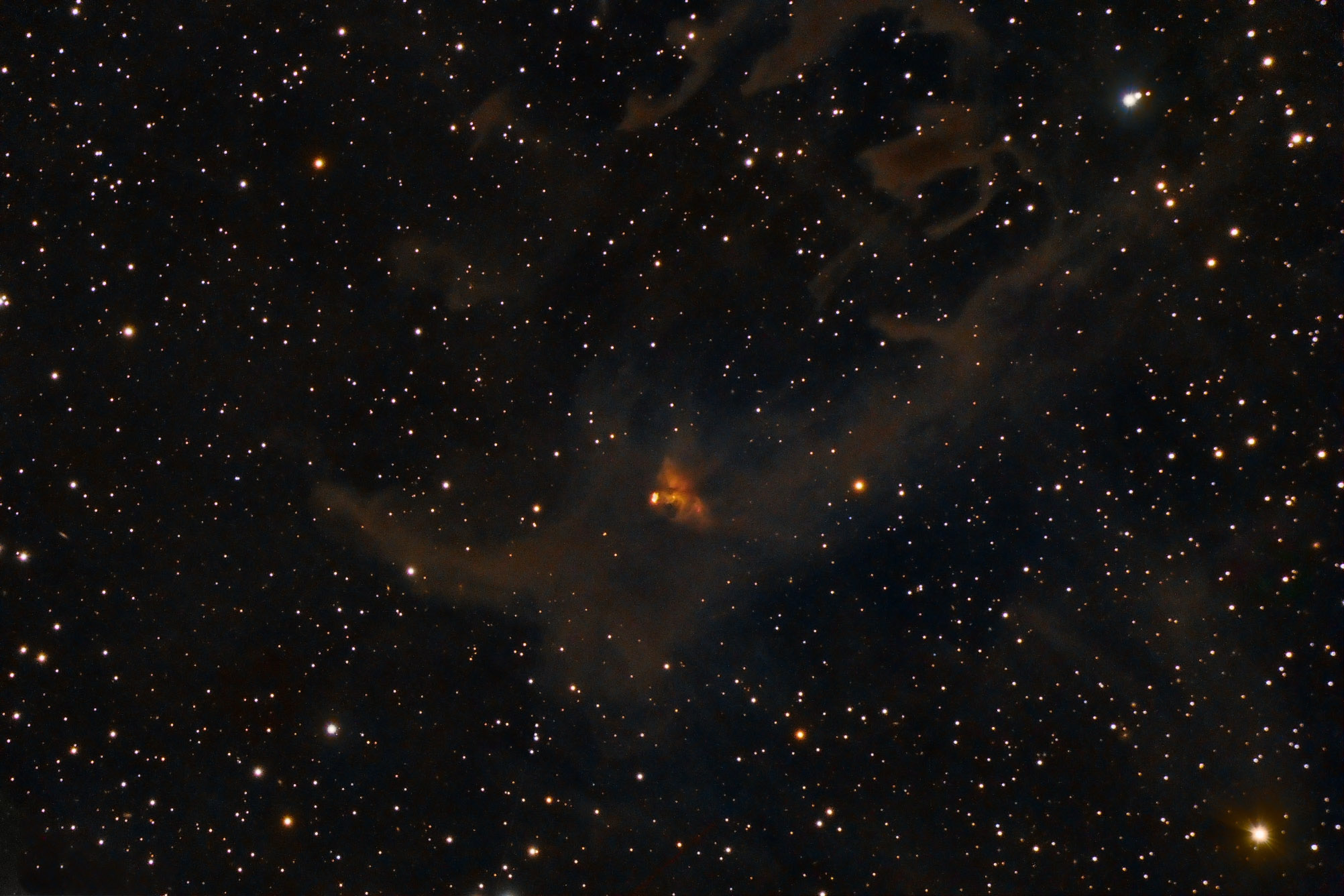
GN21-00-04L3X10RGB2X10R.JPG

GN21-1-3L4X10RGB2X10R2-67ID.JPG
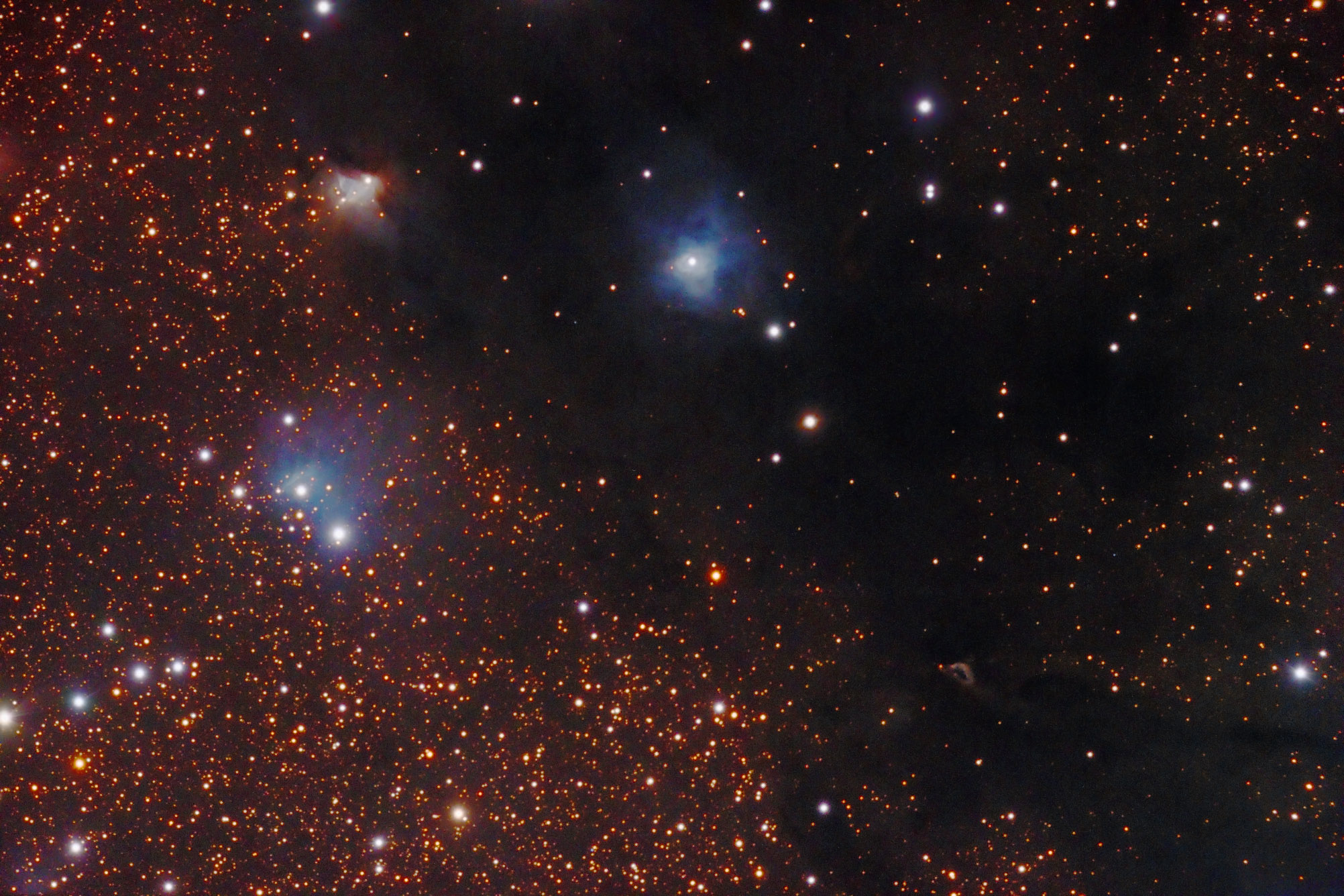
GN21-1-3L4X10RGB2X10R2.JPG
| Interesting dark nebulae in Cassiopeia.
Trying to identify what dark nebulae are in this field turned out surprisingly difficult, at least for me. Most posts of the area on the net simply call it LDN 1295. The only problem is that nebula's center is just off the bottom right edge of my image and is said by SIMBAD to be 10 minutes of arc wide. As such it would extend only one sixth the way across my image. So maybe the dark nebula coming in on the right is LDN 1295 but that leaves 5/6ths of the field still to be identified. Though most posts refer to a much larger area as LDN 1295 than it really is. I suppose to take the easy way out. I spent much time digging through SIMBAD and the catalogs it referred to. The annotated image points to the centers of the various objects I could identify. Most had no size given. The exception was TGU H809 with a size of 0.83' by 0.53', way too small to cover the entire dark area it is in. Though I've seen some posts refer to that cloud's entire extent with that name. I suppose my like for galaxies shows here as I can find those without all these issues. I'm left scratching my head each time I try to track down many dark and bright nebulae. The field is about 4.1 degrees south and a tad west of the PAC Man nebula, NGC 281, in Cassiopeia. I was unable to find a distance estimate for this complex. Though one paper puts the distance to LDN 1295 at 980 parsecs (3200 light-years). It's likely that nebula, mostly out of my frame, is part of the same complex.
While there are several galaxies in the image all are from the 2MASS catalog. NED has no redshift or even magnitude data on them let alone classifications etc. All are identified only by their J2000 coordinates. With nothing useful to use I didn't include them in the annotations.
By the f ratio myth held so dear by some, an f/10 scope would need a ton of time imaging something as faint as this object. Yet I used only my usual time I do for galaxies. Far less than most who image this area. This is because it is aperture and image scale, not f ratio that determines the exposure time. Most use smaller apertures, often 4" refractor class scopes with one 12th the capture area and thus need 12 times the exposure at my image scale. Obviously, sky conditions are important as well but under similar conditions, it is aperture and image scale that determines exposure time for a given signal to noise ratio, not f ratio, though it can be involved in determining image scale but need not be. I use an 18 micron pixel. If a 9 micron pixel is used on a 14" f/5 scope the results would be similar as would using a 4.5 micron pixel on a 14" f/2.5 scope. All put the same number of photons per minute into a pixel imaging the same amount of sky thus results will be equivalent.
14" LX200R @ f/10, L=4x10' RG=2x10' B=3x10', STL-11000XM, Paramount ME | 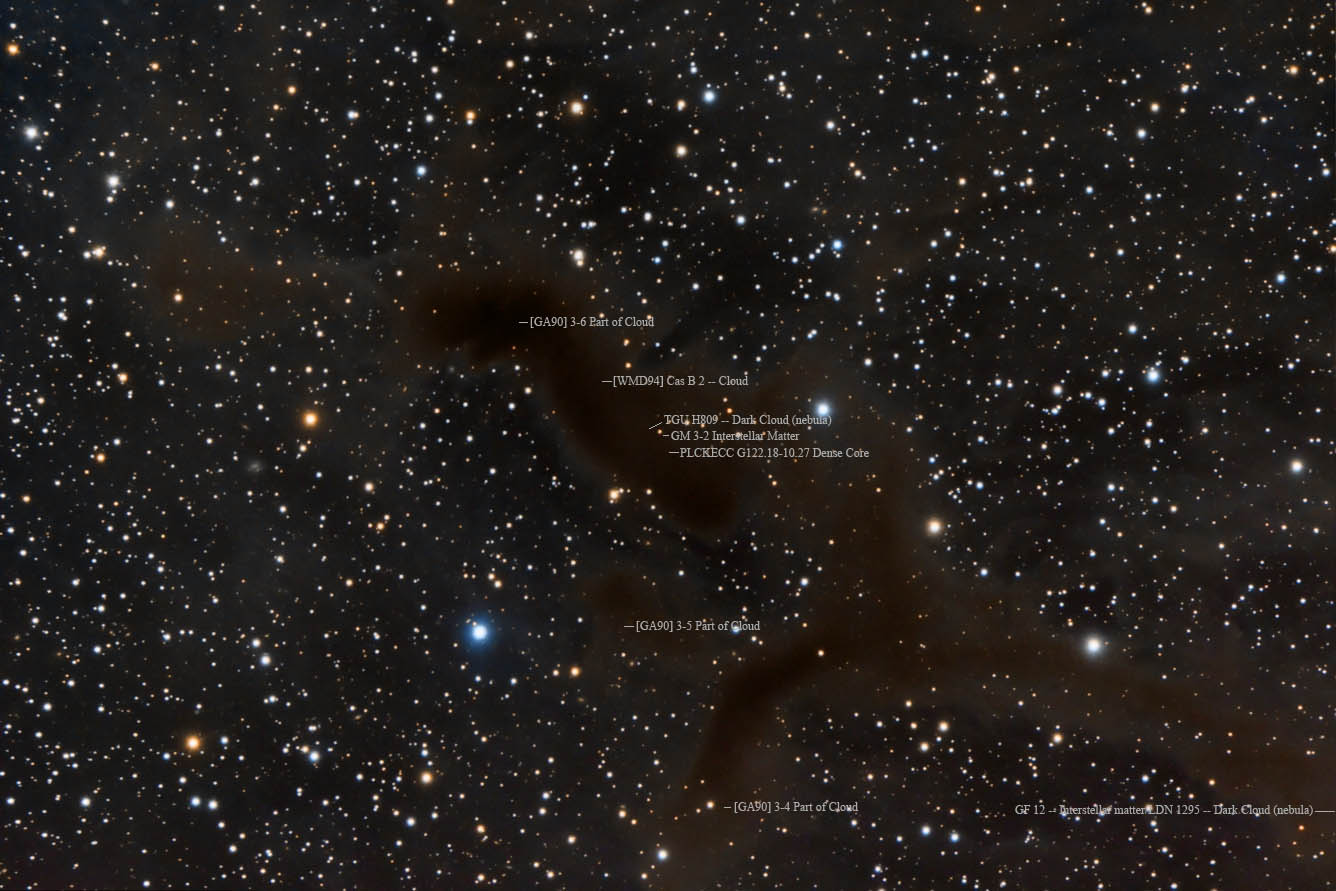
GSC3655L4X10RG2X10B3X10-67ID.JPG
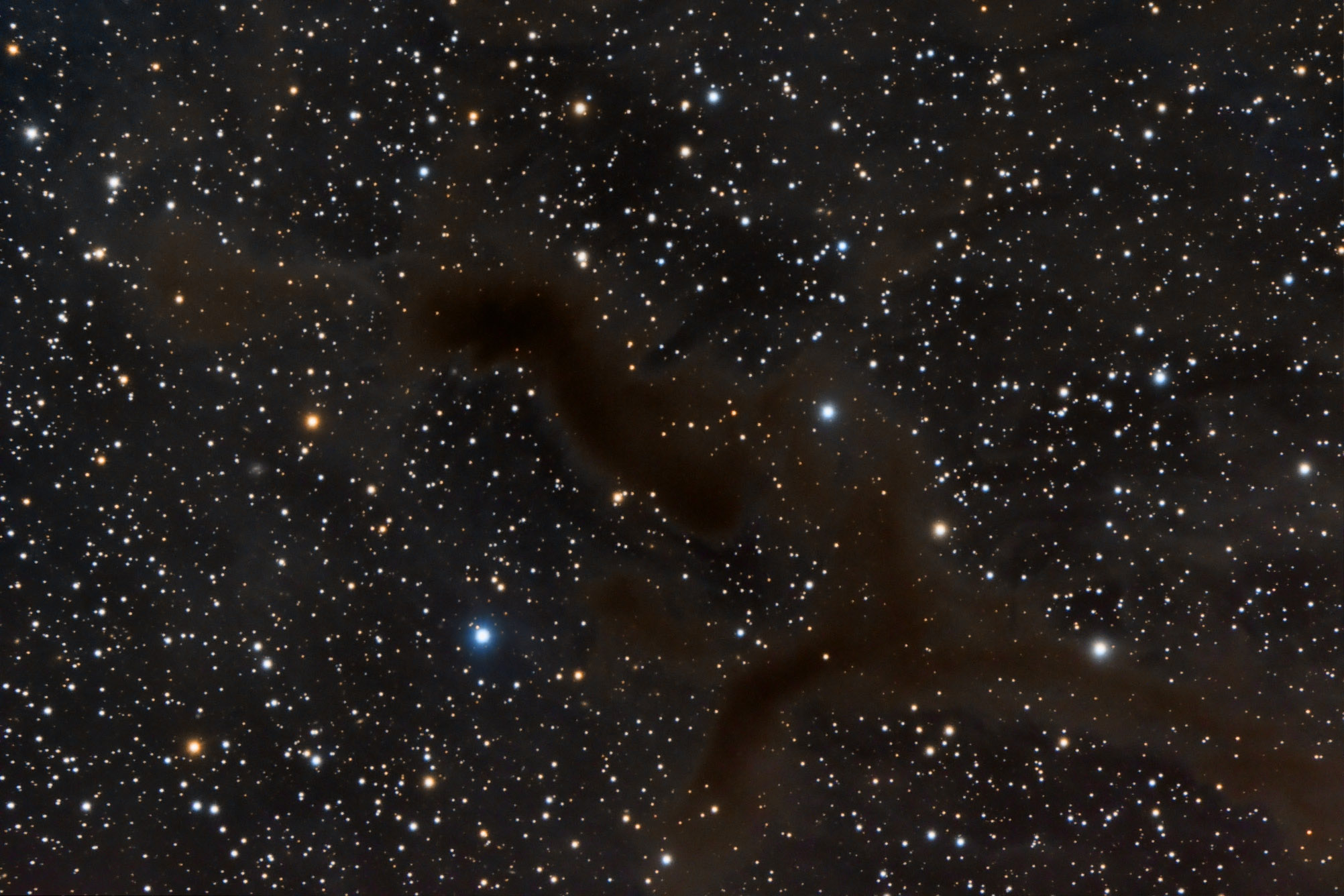
GSC3655L4X10RG2X10B3X10.JPG
| The Tower of Babble, that is the many catalog names for the same object, got me again. Seems I entered this object on my to-do list twice, once under Gum 85 and once under SH2-54. The result is the computer that decides what to take, when, dutifully took SH2-54 back in August of 2010 and then again in August of 2012 took Gum 85. Processing so many images I didn't catch it until I finished the processing. Seeing this version is an improvement over the first I decided to run it. Besides, this was one of the few images taken under rather good skies all of 2012.
Sh2-54/Gum 85 is a huge star-forming region in Serpens Cauda. It is part of the Serpens OB2 Association, a large star-forming region. I couldn't find any distance for it but most consider it related to the open star cluster NGC 6604 (a couple degrees out of my frame). That does seem to have a good distance measurement of 5,500 light-years based on Hipparcos and other sources. Though I've found a very wide range on the net these seem to be based on older, less accurate measurements. For more on this area of the sky see:
http://www.ifa.hawaii.edu/publications/preprints/08preprints/Reipurth_08-209.pdf
Sh2-54 is far too large for my system being about 9 square degrees in area. It does have a brighter area that does fit my image scale so that's the part I centered on. Note there are several "elephant trunk" features in the image. They all point back to NGC 6604 confirming its association with this nebula.
You can see the entire nebula at Dean Salman's website:
http://sharplesscatalog.com/Sharpless.aspx?Sharp=54
Normally I display images with north up. I am making an exception here and have oriented it south up. This is because my sick brain sees this nebula looking like a chihuahua making a rather rude gesture with its front legs. Maybe it should be known as the Rude Chihuahua Nebula? Since a chihuahua's leg can't bend in that direction without breaking that may explain why it is mad. I should mention I'm no fan of that breed. My maternal grandmother carried one wherever she went (almost 8 decades before Paris Hilton). I was 4 and told to kiss grandma good night. The dog chomped on my nose so hard I needed quite a few stitches. Next night I was told to do the same. I put up quite a fight but lost. This time the bandages helped, I only needed two stitches replaced. A couple days later my cat killed the blankety-blank dog much to my glee. The dog annoyed it one too many times. The cat was 20 pounds of muscle (mostly Maine Coon), Chihuahua 3.5 pounds of trembling "Jello" and sharp teeth. So is it getting back at me from the skies? My wife claims it looks like a pig but she had no encounters with that chihuahua.
14" LX200R @ f/10, L=4x10' RG=2x10'B=3X10' STL-11000XM, Paramount ME | 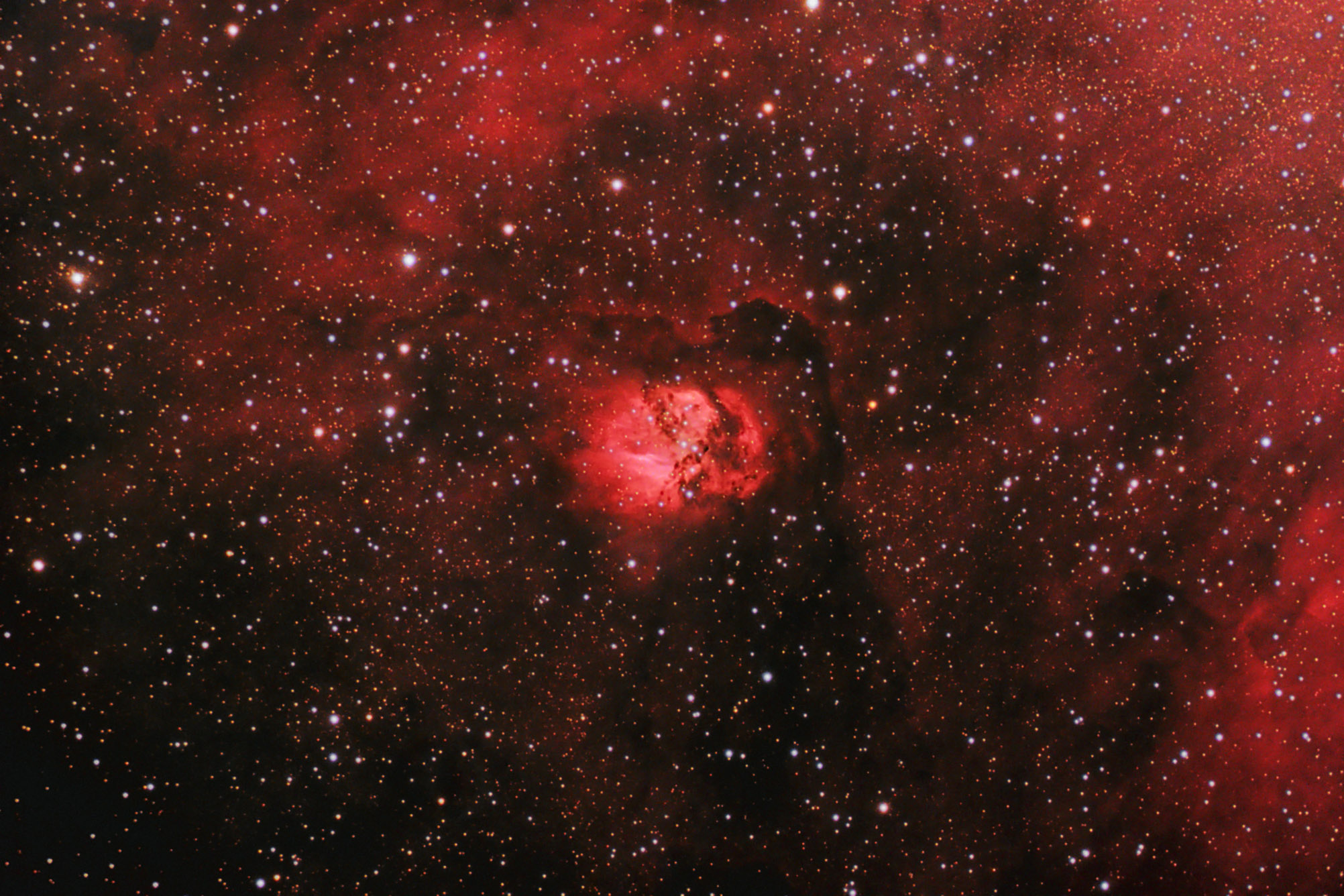
GUM85L4X10RG2X10B3X10RO1.JPG
| As you've probably noticed I like imaging things few others do. This one certainly falls into that category. Not only that it was just discovered last year. It appears unique in the universe. At least we know of nothing like it anyplace in the universe. Or so we thought when I wrote this -- I've since imaged two others. It is known simply as Hanny's Voorwerp. If you put voorwerp into a Dutch English dictionary it will tell you it means "object". But to those studying this voorwerp a more correct translation would be "What the #$(* is this?". Also, who is Hanny? The story is long so those that already know it can skip to the image. The rest of you might find the saga rather interesting.
First I need to explain Galaxy Zoo. You have noticed how many uncataloged galaxies lurk in my images. Galaxy Zoo is part of a project to remedy this using the help of anyone interested in astronomy. It is attempting to classify these faint fuzzies. They are sending out images of them to folks like you to determine if they are an elliptical, spiral or irregular galaxy and if spiral, do they spin clockwise or counterclockwise. The latter had some surprises though more to do with psychology than galaxies. The project has expanded greatly since I first wrote this. Anyway, Hanny is Hanny van Arkel a preschool teacher in the Netherlands. One of the "galaxies" selected for her to categorize was this one. These are sent to several and only when all or most agree is the category accepted. In this case, only Hanny thought something odd. She posted a note to the galaxy zoo forum asking others to look at her mystery. All told her to contact the bigwigs running the project but one of the moderators jumped in and soon things got really interesting. Only recently has a possible solution to this mystery been proposed that seems possible.
But I need to go into why this was such a mystery. First off Hanny's Voorwerp is bright green. This is a rare color in the universe. Stars can't be green due to the way our eyes see color and how quantum physics works. Ionized oxygen can as can ionized hydrogen in one wavelength but normally if that wavelength is present the red one is even more obvious and we see the object as pink not green. Her voorwerp is the size of a galaxy yet contains only dust and gas, no stars can be found in it even at infrared wavelengths which should turn up stars in thick dust and gas. It is the only galaxy sized intergalactic cloud of ionized gas known. But where do you get the energy to ionize it? It is estimated you'd need the energy of billions of stars far hotter than our sun to do the job and they'd have to be right at its surface. Here you have something giving off as much energy as an entire galaxy but at odd wavelengths that turn it green that contains NO energy source. YIKES. This is magic, not science.
First thought was that the nearby galaxy IC 2497 may have had its black hole eat something huge about 100,000 years ago and that turned it super bright. That light then hit this huge gas cloud and due to geometry that reflected light is just now reaching us. Such light echoes are known but this one is very bright and again, the illuminating light couldn't be green. Nor would it likely have the ultraviolet energy needed to ionize it like we see here.
So why is it green. It turns out most of the light it emits is OIII and H-beta emission but no Halpha to speak of. Normal ultraviolet light can't make strong Hbeta and weak Halpha. Physics just doesn't allow this. The current best guess is that a few hundred thousand years ago the galaxy passed through a small cluster of galaxies out of my image frame. In doing so it was stripped of nearly all its dust and gas which then formed as a galaxy sized cloud far outside the galaxy. In the meanwhile star orbits in the galaxy were shaken up and some fell into the black hole that is thought to lurk in the center of most galaxies. We can't see it as it is deep inside the galaxy. Radio telescope data shows an intense beam of radiation (high-energy particles not light) is being beamed from the center of the galaxy right toward Hanny's Voorwerp. Also, these scopes show a far larger cloud of hydrogen gas of which Hanny's Voorwerp is just a small part, the part this particle beam hits. A beam of high-energy particles can create this green cloud if its composition is right as apparently, this one is. But only the side of the cloud facing the beam is lit. Most are shielded by the glowing gas. We see only the parts where the cloud is thin enough that we can see the lit portion. This explains the light and dark regions we see. As a side note, Hanny was invited to the radio observatories that may have solved the mystery to participate in the release of their research.
A lot more work needs to be done to pin this all down, however. So stay tuned. It will also be interesting if the voorwerp changes its shape and brightness with time. As the particle beam is blocked by possible clouds still in the galaxy it could change rapidly much as the far smaller variable nebula in our galaxy such as McNeil's Nebula I featured a few updates back. Here are a couple links you might find interesting.
http://www.astr.ua.edu/keel/research/voorwerp.html
http://www.universetoday.com/2008/11/25/hannys-voorwerp-revealed/
The photo with the second link was taken with the William Herschel Telescope which is far larger than my house and one of the worlds major scopes. You can compare it to my efforts.
Since I wrote the above in 2008 more has been learned. Here's what I said in 2011.
Finally, two years later Hubble investigates this mystery cloud of green gas near IC 2497. It turns out to be OIII emission from gas left over when the IC 2497 tore apart a passing galaxy. The cloud is far larger than seen in visual light. The interaction fed the galaxy's black hole. This, in turn, lit up the black hole, much of the light being blocked by infalling dust and debris. The high-energy UV light that did escape in one area lit up a small part of the cloud causing the OIII to glow its green color. I see no explanation of why H alpha emission, normally seen when OIII is present, is not seen in this case.
The black hole is now "sleeping" and no longer emitting much light. But since the path from the cloud to us is hundreds of thousands of light-years longer than the direct path from the black hole to us we are seeing a light echo from the black hole. Same as we hear a sound echo long after the source of the sound has stopped. The diagram of the path of the passing galaxy that left the debris cloud shows the arrow ending about the location of a small very blue galaxy immediately east (left) of the main galaxy seen on my image and Hubble's IR image. The latter shows it to be far larger as seen in IR light than in visual light. Is this the galaxy that left the material making up the green cloud? Again, the article doesn't seem to say. Though probably not. It's likely the galaxy that left the cloud is now part of IC 2497. In other words, they merged. This would explain the debris cloud mostly hiding the black hole that lit up a part of the cloud. Though the arrow in their diagram doesn't show this the text does indicate a merger is likely. I just wish the text was clearer on this.
HST visual image and story
http://hubblesite.org/image/2803/news_release/2011-01
HST IR image
http://hubblesite.org/image/2805/news_release/2011-01
Diagram
http://hubblesite.org/image/2806/news_release/2011-01
IC 2797 is listed by NED at 660 million light years light travel time though I've seen other estimates putting it at 800 million. The edge on galaxy in the full image is LEDA 090934 at 621 million light years per NED. I've attached two versions. First is a 2x crop of the Voorwerp and the second the full frame.
In 2015 I imaged two more galaxies with green voorwerp like features. See my posts for NGC 5252, NGC 5972 and UGC 11185 for two more of these very rare objects. Here's an article on these two and the others discovered so far: http://www.skyandtelescope.com/astronomy-news/hubble-finds-ghosts-of-quasars-past-042215234/
14" LX200R @ f/10, L=4x10' RGB=2x10'x3, STL-11000XM, Paramount ME Related Designations for HANNYS VOORWERPIC 2497, 2MASX J09410407+3443585, SDSS J094104.11+344358.4, GALEXASC J094104.22+344358.3 , GALEXMSC J094104.22+344358.6 , IRAS 09380+3457, IRAS F09380+3457, AKARI J0941044+344358, NPM1G +34.0168, NSA 136023, LEDA 165538, FIRST J094104.0+344358, NVSS J094104+344356, IC 2497:[RGJ2010] C1, HANNYS VOORWERP, IC2497, | 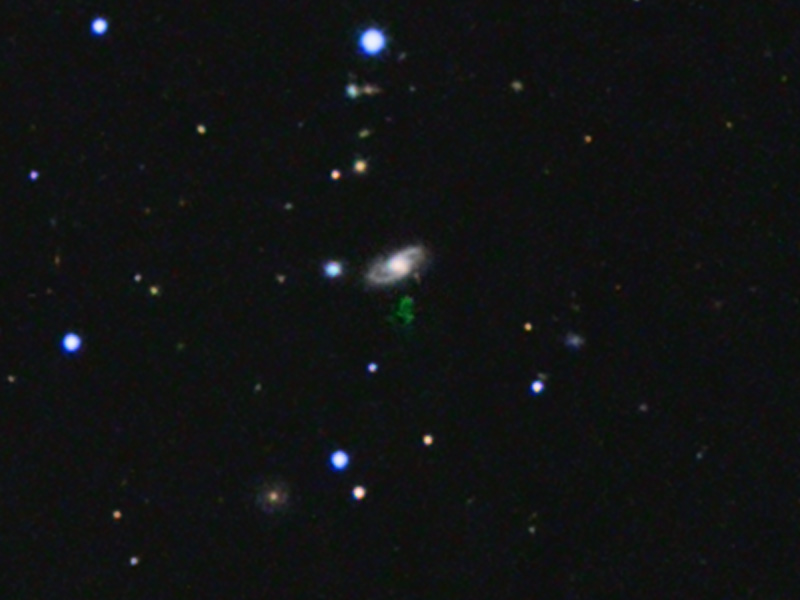
HANNYS-VOORWERP-L4X10RGB2X10X3-200CROP.jpg
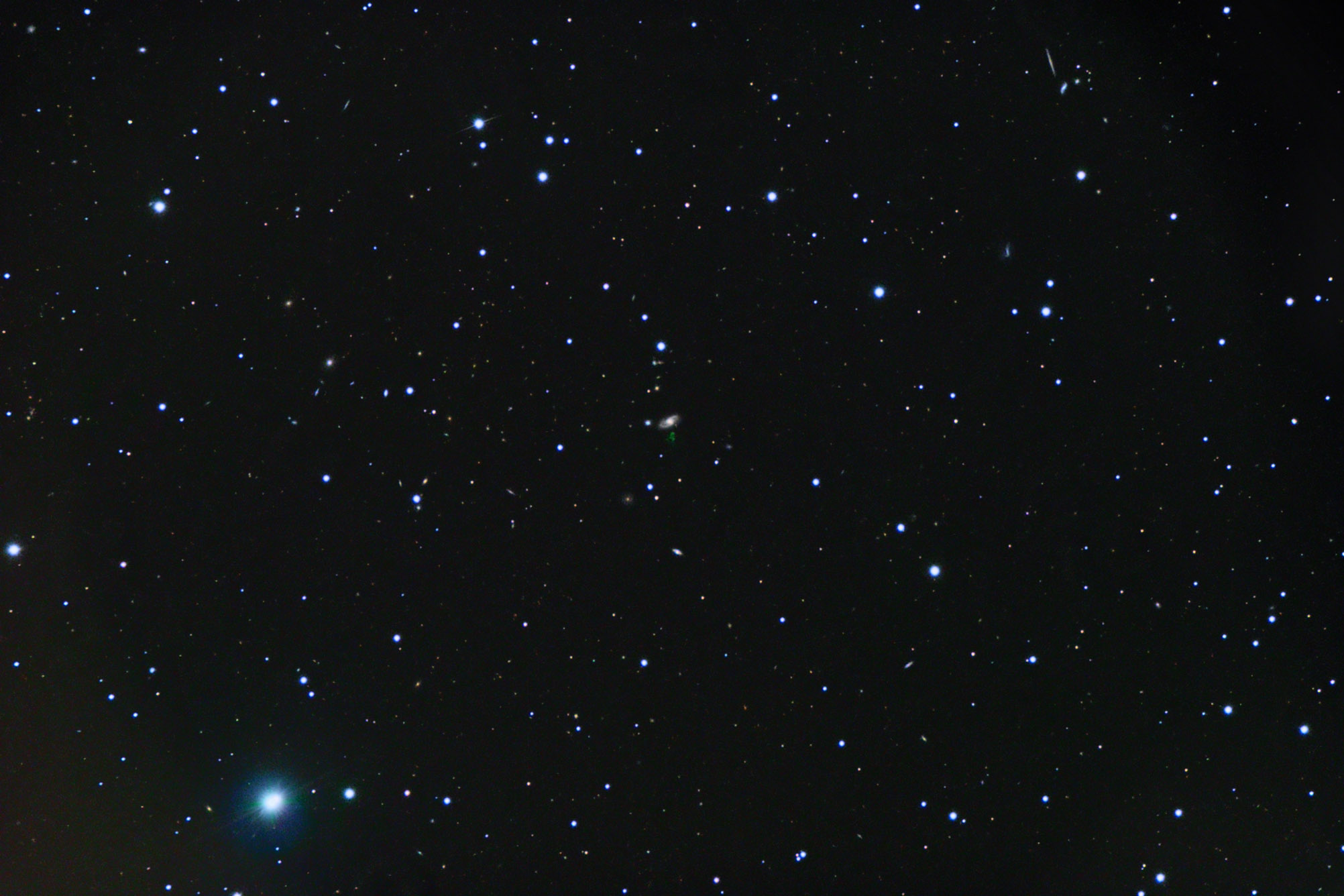
HANNYS-VOORWERP-L4X10RGB2X10X3.jpg
| HCG 051 is a group of 7 galaxies in northwestern Leo. The two brightest galaxies are NGC 3651 and NGC 3653 both discovered by William Herschel on April 10, 1785. A third galaxy is IC 2759. It wasn't discovered until over 100 years later by Guillaume Bigourdan on April 24, 1897. The others apparently escaped discovery until after Dreyer had finished the NGC and its IC entries. I have nothing on their discovery. Hickson published his list of 100 groups in 1982. With 7 rather large and bright members it is one of the richer groups on his list yet not all that well known.
HCG 51F, aka PGC 034899 is the strange galaxy of the group showing either a very sloshed core drawn to NGC 3651 or a plume. I found nothing on it to decide the issue. Another possibility is that it is entirely normal and the northern half is just lost in the stars of NGC 3651. It's disk stars are a bit bluer than those of NGC 3651 so I'd have expected them to stand out thanks to the color difference but I don't see that either in my image or the Sloan survey image. I found no other images online to help here.
In the upper right corner is the galaxy PGC 034804. NED classifies it as an Irregular galaxy. To me it is an obvious two arm rather open spiral galaxy. Say an Sb or there about. Thus I added "??" after NED's classification. It, like many in the image, appears to be a member of the same group as the HCG 051 galaxies. Just a much smaller member than the main ones making up the group itself.
The Minor Planet Center reported 2 asteroids in the image. I can only find the fainter one. Its trail is very short and is at 20.4 magnitude by the Minor Planet Center's estimate. the other is 20.0 by their estimate but its track is similarly short and entirely within ASK 624844.0. Being brighter I was unable to find the asteroid. The one I could find is lost in the annotated image but is due south of the HGC group below the densest section of the annotated image.
This brings up a problem I had annotating it. Normally I just ask NED and Adladin to mark those in my frame with redshift data and I annotate those. Sometimes one or two are too faint but that's rare unless my night was poor. Sometimes this results in only a few galaxies, with 25 to 40 being normal and once in a while up to 100. But when I did that for this field I about had heart failure. It returned 12,892 galaxies. The result was an image nearly totally white with marked galaxies. What happened? I was sure something was wrong so got the data for one and checked my image. It was there. Then another and another with the same result. Then I tried another that was marked as being taken with a red filter. My camera is very insensitive in deep red. It wasn't there yet at magnitude 21.1 was brighter than a green one of 22.5 magnitude I easily saw. Then I noticed that almost all of the "extra" galaxies came from a catalog I'd not heard of the RCS catalog. That stands for "Red-sequence Cluster Survey" I suppose that explains all the red photometric magnitudes. All from that catalog had photometric redshift calculations rather than spectroscopic I was used to in most cases. These are much cheaper to obtain in bulk but not as accurate. Still, they usually give a reasonable estimate. As usual, those are noted with a "p" after the look-back time distance.
Now I had a problem how to annotate these. In the 5' center of the image (not the center of the cluster but close), I chose to annotate those brighter than 21.0 magnitude. I soon came to realize this was not going to work. I downloaded all 12892 entries into a text file then sorted out those dimmer or equal to 21.0. That left a huge file. I didn't try to count them but over 1000 I'm sure. No way that was going to work so I dropped my limit to 19.99 or brighter. That left me about 140. I gulped and dove in. I didn't have the aids I normally have as I never figured out how to limit NED and Aladin to my 19.99 limit so had to find them the hard way. Took some 5 hours. I've got to find a better solution if that RCS catalog is now widespread in NED. I've not had time to go check. But thanks to its photometric distance data hundreds of SDSS and 2Micron galaxies that had no redshift now do. I suppose one answer is to eliminate all NED notes as being photometrically determined. That would put me back to where I was before but since I can't, as yet, find a way to filter Aladin to do that I'll still be doing it the hard way.
14" LX200R @ f/10, L=4x10' RGB=2x10', STL-11000XM, Paramount ME Related Designations for HCG051HCG 051, WBL 326, USGC U381, PCC N67-311, MCXC J1122.3+2419, v2MCG 42, RASSCALS NRGb 128, RXC J1122.3+2419, [RPG97] 128, NGC 3651, UGC 06388, CGCG 126-042, CGCG 1119.8+2434, MCG +04-27-028, WBL 326-004, HOLM 249A, PGC 034898, NGC 3653, CGCG 126-044, CGCG 1119.9+2432, MCG +04-27-029, 2MASX J11223008+2416457, 2MASS J11223006+2416460, SDSS J112230.06+241645.3, GALEXASC J112230.07+241647.8 , HCG 051C, WBL 326-005, USGC U381 NED01, ASK 624810.0, HOLM 249B, NPM1G +24.0240, NSA 112253, PGC 034905, SSTSL2 J112230.07+241645.8, UZC J112230.1+241646, UZC-CG 138 NED03, FIRST J112230.0+241646, NVSS J112230+241644, CXO J112230.0+241645, 2XMM J112230.1+241643, 1XMM J112229.8+241644, [TTL2012] 142570, IC 2759, ARK 290, CGCG 126-041, CGCG 1119.5+2436, MCG +04-27-027, 2MASX J11221325+2419017, 2MASS J11221327+2419023, SDSS J112213.28+241901.7, GALEXASC J112213.22+241902.9 , HCG 051E, WBL 326-003, LDCE 0802 NED002, HDCE 0645 NED001, MAPS-NGP O_375_0223994, NPM1G +24.0239, NSA 139264, PGC 034881, SSTSL2 J112213.28+241902.1, CXO J112213.2+241901, 2XMM J112213.1+241900, 2XMMp J112213.1+241900, 1XMM J112213.2+241901, v2MCG 42:[DMP2012] 2, [DZ2015] 678-02, HCG051, NGC3651, NGC3653, IC2759, | 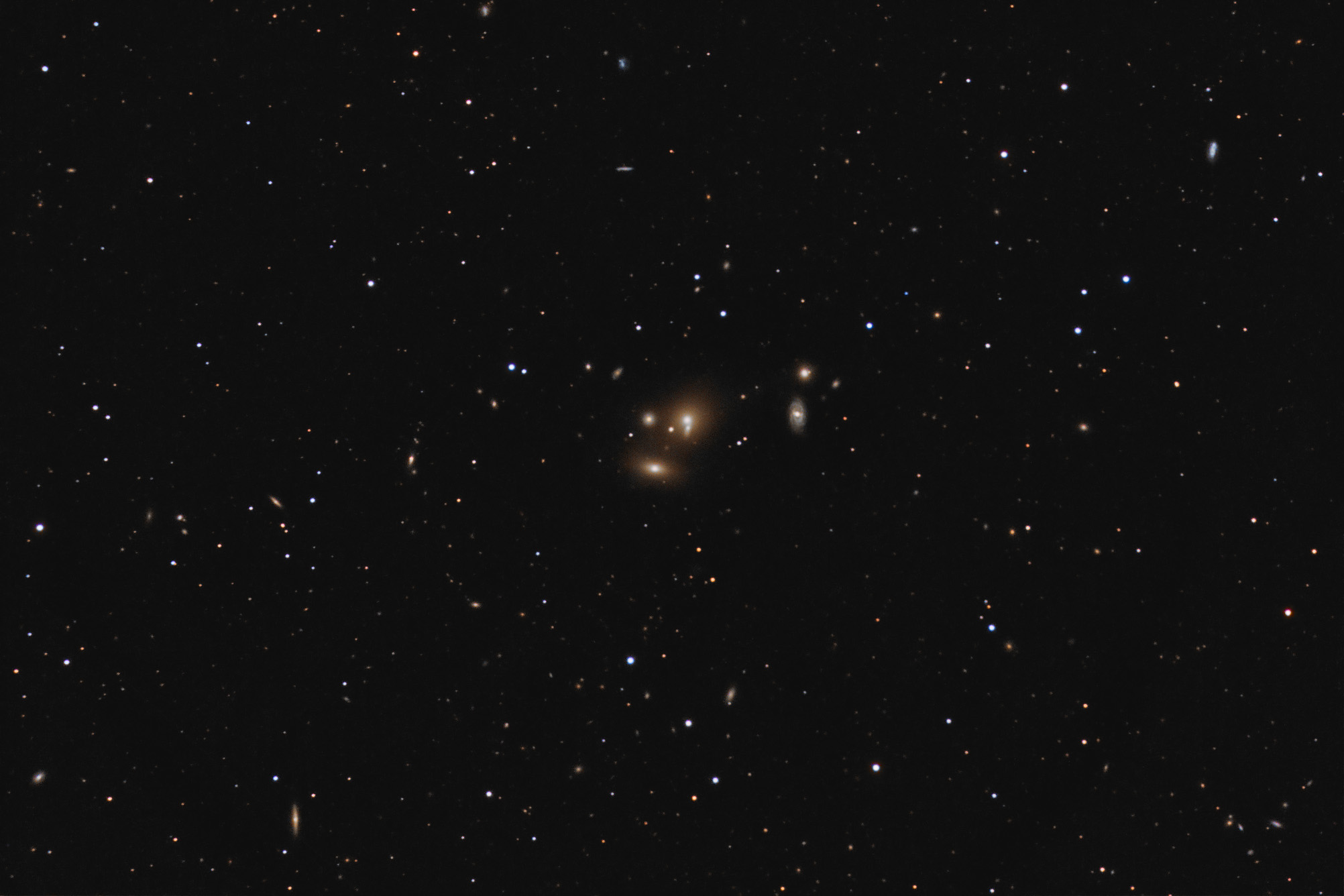
NGC3651L4X10RGB2X10.JPG
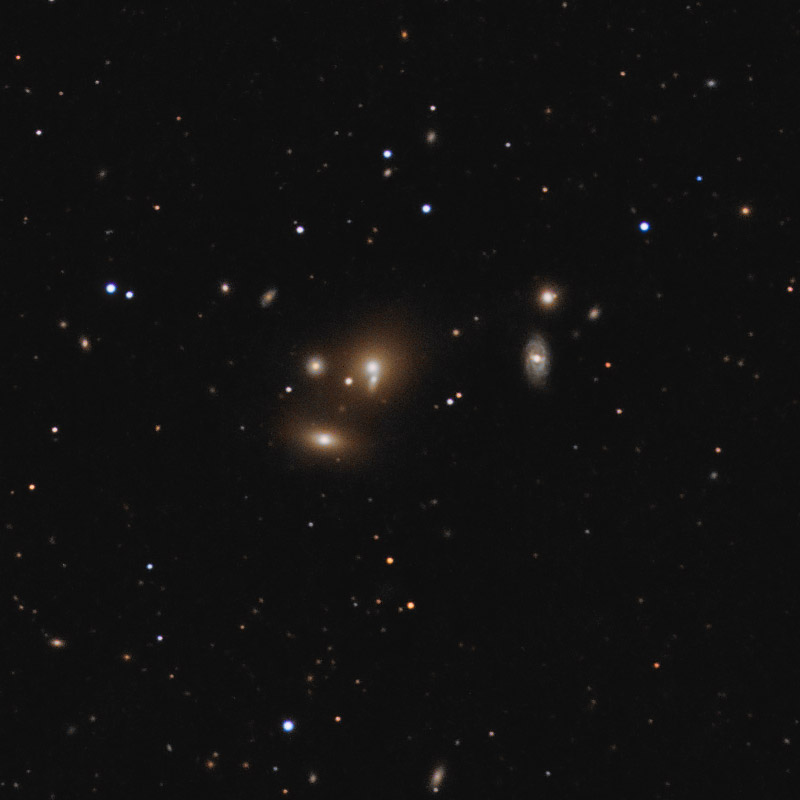
NGC3651L4X10RGB2X10CROP.JPG

NGC3651L4X10RGB2X10ID.JPG
| 



















